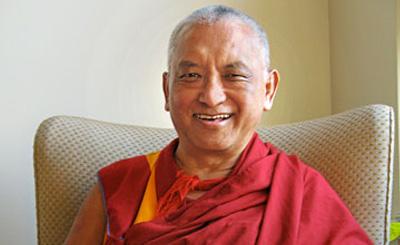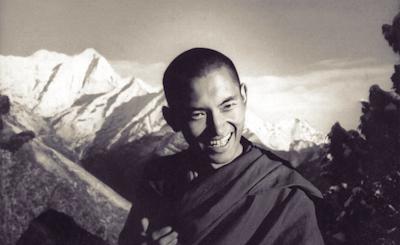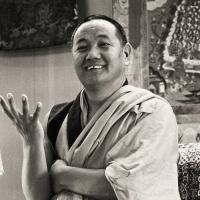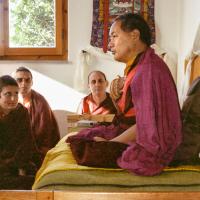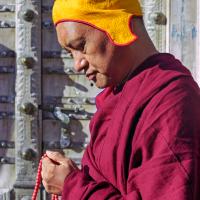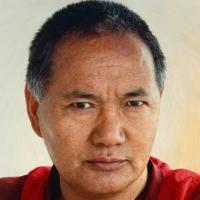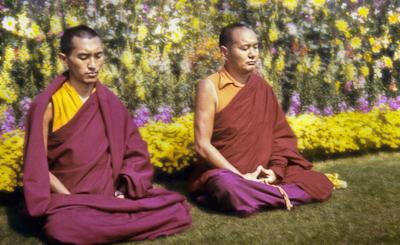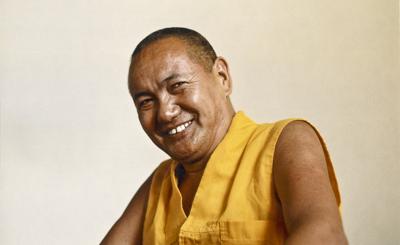Dharma practice is impossible with the eight worldly dharmas
The great bodhisattva Thogme Zangpo said,
There is no greater hindrance to taking the holy Dharma on the path to liberation than the evil thought that completely concentrates on obtaining the perfections of this life. Therefore, it is necessary to always avoid this.
The thought of the eight worldly dharmas is the greatest hindrance to Dharma practice. Mix the work for enlightenment with the work of this life and enlightenment is lost, just as food becomes inedible if it’s mixed with poison.
We honestly try to do virtuous things—listening to the teachings, studying, reflecting or meditating—but somehow things never work out well because the thought of the eight worldly dharmas always disturbs us. Here is the most delicious food, but it’s tainted with poison. It looks enticing but it’s inedible. We have to throw it out.
With poison in our system, we’re sick with pain and headaches and nothing tastes good. As long as our mind is under the control of the eight worldly dharmas, everything we do is poisoned and no matter how much we try to manipulate our external conditions and acquire material comfort, it doesn’t stop the problem. In the same way that we can’t be healthy until we’ve flushed the poison from our body, we can’t really be happy until we’ve flushed the poison of the eight worldly dharmas from our mind.
Until then, we might act renounced but it’s all just show. Even if we fast, keep silent or live in an isolated place, all these activities become worldly dharma because the motivation is worldly.
If we wash a white shirt with a black one, the color runs. The black stays black but the white goes grey. When we Tibetans spill butter tea on the white page of a Dharma book, it’s impossible for the paper to be white after that. In the same way, a mind mixed with both holy Dharma and the eight worldly dharmas can never be pure; the mind is stained throughout by the evil thought of the eight worldly dharmas.
Thogme Zangpo also said,
Even though we hold the lamp of the teachings in our hand, we still obscure our mind. The clouded, evil thought blinds our eye and leads us over the precipice of sin, creating problems for ourselves and those around us.
Dharma teachings are likened to a lamp because they dispel the darkness that prevents us from seeing things as they are. However, even though we know many words of the teachings and can explain them to others, still, somehow, we do not practice and our mind does not become one with the Dharma. So even though we hold the lamp in our hand, we still can’t see through the darkness. It’s as if we have eyes but they’re damaged in some way, say by cataracts that make us see falling hairs or by something that makes us see two images where there’s only one. Obscured from seeing reality by the eight worldly dharmas, we create all sorts of problems for ourselves and others.
Every negative action we create brings us one step closer to the precipice; every negative action we do makes our appointment with the suffering lower realms more certain. As long as we fail to recognize and avoid this, our mind cannot become one with the Dharma—like milk and water mixing—and we will always have problems.
The Dharma becomes our enemy. Not understanding that this is the only method to subdue our mind, we interpret what is explained by our teachers as something harmful. If we could become more friendly with Dharma wisdom, then when we heard the teachings that explain wrong conduct we’d see them as an antidote to the three poisonous minds. However, if we remain friendlier with the thought of the eight worldly dharmas, then to our disturbed, unsubdued mind the holy Dharma seems just the opposite. Our attachment doesn’t want to be pacified. Controlled by the eight worldly dharmas, our mind sees the Dharma as a threat.
In this way, by not letting one single action that we ever do become Dharma, the thought of the eight worldly dharmas destroys the incredible potential of this precious human life. Even if it’s been a long time since we met the Buddhadharma, so far we’ve been unable to gain any realizations. We work and work but somehow there’s still no change in our mind; it’s still the same old mind. If it hadn’t been following the thought of the eight worldly dharmas then there would definitely have been a profound change by now.
We try to practice but somehow our mind is too weak. We haven’t done enough meditation on impermanence and death, the suffering of the lower realms or the general shortcomings of samsara. Somehow, in the depths of our heart, we don’t want to face it, afraid that if we renounce samsaric pleasure we’ll lose all our fun, all our happiness. This gap between logical understanding and heart yearning can make us feel quite strange. And so we ignore the meditations on the various kinds of samsaric suffering and concentrate only on visualizing beautiful objects. This can really make us crazy.
When there’s a battle between the worldly mind and the holy mind there are great hindrances to our Dharma practice. Somehow, we never seem to have time to do our practice; we can’t even manage to recite one mala of a mantra. We sincerely want to meditate but always find a reason to postpone it. This is completely the fault of the thought of the eight worldly dharmas. There’s always something else we have to do.
It’s quite funny when you look at it. We always manage to find time to sleep, eat, talk, go to the movies, do unnecessary things, but, because we’re following the thought of the eight worldly dharmas, we always find a thousand important reasons for not meditating.
Weeks, months and years go by without our practicing Dharma; we always plan to do it later. Later, later, later; after some time, after some time, after some time. Then suddenly death arrives. The Lord of Death doesn’t say, “Oh, you haven’t finished your Dharma practice. I’ll give you special dispensation. I’ll wait until you’ve finished.” Death doesn’t wait.
Living in the West amidst much material development, it’s very easy to blame the external conditions, as if we’re completely pure and it’s the outside world that’s making us suffer. However, we should not blame society or our material wealth. Nobody makes it difficult for us to practice Dharma but ourselves.
When we first come back home from a stay in India or Nepal, we might have a lot of energy to practice Dharma but, working in the city surrounded by people with a completely different attitude from ours, we get lonely. Even though we’re trying to not be concerned with the affairs of this life, everybody else we work and socialize with is totally obsessed with worldly pleasure, the happiness of this life alone. This makes it very difficult for us to maintain our pure motivation.
When our life is too comfortable, too luxurious, our mind gets out of control because there are too many distractions to our Dharma practice. And when we have personal problems, illness, family and relationship difficulties, again it is very hard to keep our mind quiet and practice Dharma. To live a life that has neither too much comfort nor too little is extremely rare. Our Dharma practice depends upon our having good, continued meditation and for that we need a stable life. We need control over the distractions of this life and this is exactly what the thought of the eight worldly dharmas robs us of.
The main reason for getting ordained is renunciation of this life, but for those who become monks and nuns without renunciation, ordination is just another attraction to this life: wearing warm robes, saying lots of prayers, making a big noise like a tiger roaring. It’s possible that we enjoy the beautiful robes and the interesting customs and feel good just because other people respect us. Things that lay people find hard to obtain—food, clothes, a good reputation—come to us easily.
We might wear robes, hold a mala, shave our head, show the form of a perfect Dharma practitioner on the surface—externally everybody can see that we’re a seeker of liberation—but with a mind clinging to this life we’re unable to engage in the actions of a Dharma practitioner, we never do anything of great meaning. No matter how much Dharma education we receive, instead of our mind becoming more subtle, more pliant, it becomes more rigid, like iron. We become more tough skinned.
The thought of the eight worldly dharmas is the thing that stops us practicing Dharma, so the first step on our spiritual journey has to be renunciation of the attachment that clings to this life. If we want to fly to California we have to start by getting out of bed. We can’t step into the airplane from our bedroom—we need to get up, get dressed, get into a taxi and go to the airport. In the same way, if we really want to practice holy Dharma, the very first step is to renounce this life, to renounce the attachment seeking the happiness of this life.
Pure meditation is impossible with the eight worldly dharmas
When we try to meditate, the thought of the eight worldly dharmas makes it impossible to concentrate. It continuously distracts us, taking us away from our object of meditation and directing us to an object of attachment.
We even find it hard to start meditating. We have the thought that it’s time to meditate but it somehow takes us too long to get around to it. We’re about to start but there’s a distraction, so we put it off. We try again but then there’s another distraction—ten minutes, half an hour—just one more little thing and then we can meditate ... and then one more little thing. Our attachment tells us we’ll be able to meditate much better once we’ve cleared our mind of that concern. “Do the practice later,” it tells us; “First you need to do this for me.” And so it gives us such wonderful advice.
We think that we need to sleep well to remain healthy and have a clear mind. It’s so hard to meditate when our mind is foggy with exhaustion. This is true, but is that the real reason we stay in bed longer or is it because our bed is so warm and comfortable? We feel resentful that everybody else in the whole world is sleeping but we have to get up in the cold and sit on a hard floor. Nobody is forcing us to do this, so why are we being so masochistic? Thinking like this, the minutes tick by and we’re still under the covers. Then it’s time to have breakfast and suddenly we have to rush to get to work. Being late and having no time to meditate was not caused by lack of time but by seeing comfort as more important than practicing Dharma.
Maybe we force ourselves onto the meditation cushion and try to meditate but our mind gets bored. We can’t stick with it. We tell ourselves it’s not working. “I’ve been meditating for over a week and I still don’t have any realizations.” And so we find excuses to quit—we’ll meditate tomorrow or some other time when we have more energy; today we’re a bit tired so it might be better to go to the beach.
I hear from many students, especially when I’m in America, that they have no time to meditate. However, they do have time to sleep—a lot of time. They do have time to eat—a lot of time. And to drink, and to talk. The mind preoccupied with worldly concern blocks the sense that meditation is more important than the worldly activities that fill their day. Being too busy is not the main reason for lack of space for Dharma; following the thought of the eight worldly dharmas is. The more we follow our attachment to this life, the less time we have to practice Dharma and the more difficult we find it. And conversely, the less we follow attachment to this life, the more space we have for Dharma.
Even if we know all this intellectually, somehow we still can’t do it. We have no energy to overcome our reluctance. There’s no fuel to get the plane to fly—nothing to persuade us to have the courage to practice. Delusions take over our mind and become more and more powerful. We become a slave to the thought of the eight worldly dharmas and everything, even studying Dharma, even doing retreat, becomes a means to serve and feed it.
Even when we manage to start a meditation session with a pure motivation, the thought of the eight worldly dharmas sneaks in slowly, like a cat coming into a room. Just like a cat, there’s no noise, it’s utterly silent. Only after some time do we notice that the cat has taken things. Just like this, the thought of the worldly dharmas arises very quietly and spoils our motivation.
We try to calm our mind but the thought of the eight worldly dharmas won’t let it happen. Our mind remains agitated, like boiling water or dust caught in a strong wind, whipped around, unable to relax. We can’t concentrate for even a minute without its wandering off to an object of attachment. Our mind is full of expectations, full of clinging to this and that, full of so many things that our thoughts scatter everywhere.
Maybe we’ve decided to meditate for an hour, but for the first thirty minutes, forty minutes, even fifty minutes, we still can’t bring the object of our meditation up in our mind. And if we manage to do so, it’s only there for a second and then it’s gone, like a fly landing on a table and then flying off. We bring it back and the next second it’s gone again, over and over like this. We have so much distraction. Even if we sit for two hours, the time that we’re actually concentrating on the object of meditation is no more than a few seconds or a few minutes at most.
And what’s worse, not only does our mind not dwell on its intended object but it focuses on some object of attachment, so it’s a negative mind. While we’re sitting there trying to do a breathing meditation, the thought of the eight worldly dharmas is busy creating nonvirtue. We sit up straight and wonder whether people are watching and thinking what a great meditator we are. They must be envious of how good we are; surely they’ll ask us to teach some meditation classes.
Most of the images that come into our mind are images of either attraction or aversion, and with them come the associated emotions of pleasure or anger. Without our consciously thinking about it, these images arise all the time, and because we still have strong attachment to the happiness of this life, we find it very hard to forget them.
We might be trying to meditate but a friend is talking to somebody else in the next room. Their conversation is so interesting that our mind can no longer remain in meditation. We want to listen. Talking and listening are much more appealing. If we know something that our friend doesn’t, then because of our pride we can’t wait to leave the meditation to tell her. She hasn’t ruined our meditation; the thought of the eight worldly dharmas has. Even if there’s no conversation to distract us, there’s still that little insect biting us.
The stronger our attachment seeking the happiness of this life, the more uncontrolled our mind and the greater the distractions that arise. It’s much more difficult to keep our mind calm. If we remain aware of the distractions and images that appear in our mind when we try to meditate, we’ll easily recognize all this from our own experience.
Even if we can concentrate for five minutes at the beginning of our meditation, soon after that we find ourselves on a big trip. Sometimes we’re in the East, sometimes in the West, sometimes traveling in India, sometimes traveling in Nepal, sometimes traveling in Indonesia. We might be trying to visualize Shakyamuni Buddha but within a few minutes we’re in America, visiting family, talking to friends, doing the things we enjoy. Completely unconscious of our body, which is here, we’re away on holiday. Then, however long we spend meditating—five minutes, five hours—it all becomes worldly meditation, a meditation to create more causes of suffering. We’re meditating to remain longer in samsara. And of course, during this time we have no awareness of the object we’re supposed to be meditating on.
The thought of the eight worldly dharmas can become a hindrance even after our meditation has finished. Say we’ve managed to meditate with pure motivation and the action has become a pure Dharma action but later we get angry because we remember something worldly we could have done instead. In that way the thought of the eight worldly dharmas destroys whatever merit we might have created in the session. The result of anger is only suffering; it destroys any chance we have of achieving liberation. So it’s very important to be mindful even after we’ve finished meditating.
The eight worldly dharmas make enlightenment impossible
This thought of the eight worldly dharmas also prevents us from realizing the absolute nature, emptiness, which means we have no way to attain enlightenment. One of the great Indian pandits, Dharmakirti, explains that by its very nature, attachment distorts reality because under its influence our mind exaggerates the qualities of the object to which it’s attached by seeing intrinsically real positive qualities that are simply not there. Because of our delusions we’re unable to see the false projection we place on an object of attachment as false—to us it’s real and intrinsic—and so we’re unable to overcome this false view.
In particular, the thought of the eight worldly dharmas obscures our realization of the false nature of the self-existent I. Therefore, this is a fundamental wrong view. Even if we meditate on the absolute nature of reality in order to realize the emptiness of the self, the thought of the eight worldly dharma always arises to block our realization. It doesn’t want to be destroyed, it doesn’t want to be smashed, it doesn’t want to be extinguished. The stronger our attachment to this life, the more difficult it is to even understand the ultimate nature of the I, let alone realize it. That’s how attachment makes it difficult to be free from samsara.
If we were ever to actually realize the emptiness of the self, we would immediately see how the thought of the eight worldly dharmas has been deceiving us. It’s like a really skillful liar, one who everybody trusts completely because his lies are so believable. He lives in our house and we think he’s a good friend, but actually he’s constantly stealing our stuff. Because we trust him so much we never suspect him and always blame others for the theft. Only when we really investigate do we discover that all the time it’s our “friend” who’s been the liar and the thief, the cause of all our problems. We get a big shock because we never suspected him. So right then and there we decide to kick him out, destroy him, because there’s no place for such a person in our home.
In the same way, it’s only by realizing the emptiness of the self that we can come to understand just how completely false the thought of the eight worldly dharmas is. When we see how it’s the most damaging wrong view and the root of all the other problems we face, we’ll have the courage to destroy it so completely that even the name “attachment” does not exist in our mind. This is why the worldly mind that sees external things as true happiness is so afraid of the meditation on emptiness, why whenever we think about doing it, attachment begs us, “Please don’t.” It’s afraid for its very existence.
Like the thought of the eight worldly dharmas, self-cherishing is also a very harmful wrong conception, but we can harbor a subtle form of self-cherishing and still become free from samsara and achieve nirvana. Even with self-cherishing, even holding the wrong view of the self-existent I, we can still create virtuous actions and be reborn as a happy transmigrator, but we can’t achieve this with the thought of the eight worldly dharmas, which blocks us from not only transient happiness but also the happiness of future lives, including, of course, liberation and the ultimate happiness of enlightenment.
Achieving enlightenment depends on realizing bodhicitta, which in turn depends on realizing the mind renouncing samsara. And as long as the thought of the eight worldly dharmas is present in our mind, there’s no way to realize the mind renouncing samsara.
Just as where there’s water there can’t be fire, so where there is seeking the temporal happiness of this life, there can’t be renunciation of the temporal happiness of this life. Thus by clinging to the happiness of this life we destroy our chances of creating happiness both now and in the future.
That’s why Manjushri explained that if we cling to this life we cannot be considered a Dharma practitioner.32 Besides a few exceptional actions done without pure motivation due to the power of the object, anything we do with the thought of the eight worldly dharmas becomes the cause only for samsara, not enlightenment. We should therefore reflect deeply on the teachings of the Buddha that show the path to attain enlightenment and firmly resolve to cut off any wrong understanding.
At present we’re like babies. A mother can’t give her baby meat until his teeth have developed. If he can’t chew or digest strong food, it can really harm him, so his mother needs to feed him milk or soft food. We want to bite into enlightenment but we haven’t developed the strong teeth of renunciation. Only when our daily practice is pure and free from clinging to this life can we become excited about trying to achieve enlightenment. The problem is that many of us fail to check our motivation and therefore fail to really understand what actions are harmful or beneficial.
We want enlightenment and we want it quickly, but we must make sure that all the conditions are there. If we want to go to India we have to fly—any other way takes too long—so we really need to make sure we have enough money for the ticket. The flight is the tantric path and realizing bodhicitta and emptiness are like the ticket. Buying the ticket depends on having enough money, the mind that has fully renounced the evil thought of the eight worldly dharmas.
Thus the practice of tantra is impossible while we follow the mind of the eight worldly dharmas. The fundamental tantric practice is living in the practice of avoiding the impure thought that projects the impure view. Just as we need a strong foundation before we can build a house, this practice is the ground upon which all of tantra is based. And it’s far more difficult to avoid this impure thought than it is to avoid self-cherishing.
There’s no doubt that tantra is the quickest path, but we need to develop all the other practices before we can even consider it. We might be able to go from one country to another by sneaking past customs but that doesn’t work with Dharma practice. All the fundamental elements need to be in place if we want to achieve enlightenment.
Retreating with the eight worldly dharmas
Perhaps we’ve made it as far as a retreat hut and feel we’re beyond the influence of the thought of the eight worldly dharmas. Far from it. Here, desire can be stronger, pride can be stronger, all our delusions can come to torture us. Retreat is a wonderful way to turn our mind toward the Dharma but there are traps.
We set ourselves a big goal for our retreat—lots of prostrations, a very strict timetable, precepts every day, the determination to do the long sessions very strongly—and feel very happy about that. In fact, we start thinking we’re very special and feeling proud. When pride and ego creep into our retreat we lose much of benefit we might have gained from all our hard work and the only difference between us—alone, isolated, spending hours and hours each day prostrating and meditating—and somebody working in the city and spending every evening drinking and having fun is the location.
Maybe, jealous of our friends who’ve done a retreat in Nepal, we’re desperate to collect some beautiful stories for our retreat diary so that we can impress them. We put a big sign outside our retreat hut for everybody to see: “RETREAT” or “STRICT RETREAT” or “VERY STRICT RETREAT.” But I’m not so sure just how strict our mind is. This is a sign to our friends: “Look at me! I’m doing a retreat!” We think it’s us doing the retreat but in fact it’s the thought of the eight worldly dharmas that’s doing it.
If we’re not constantly aware of what our mind is doing, pride and the need for reputation can creep in, making all our hard work meaningless. Even if all our doors and windows have been sealed with mud and we’re living without air vents like insects in a hole,33 if our mind is attached to such a tiny transient thing as reputation, the need for people to respect us, it’s all for nothing.
Where there’s a need for comfort, there will always be distractions; somebody will always be making a noise outside to disturb our profound meditations. If it’s not an adult or a child, it’s a bird, a dog or a goat. We try not to listen but inside we get angrier and angrier. We’re doing retreat for the sake of all sentient beings, but while we’re saying those words we’re secretly wanting to kill the noisy sentient being outside disturbing our meditation.
Then there’s the danger that during the break between sessions we might actively seek out that sentient being and we’d better pray that there are no stones or other weapons around or we could become very dangerous. When we’re angry, that person or animal is the ultimate enemy, but when our anger subsides we realize it’s not like that at all. It’s the same object, but one moment that sentient being is an enemy and the next it’s not.
Even in retreat, hatred, anger and even the thought of killing can arise. Our mouth can be reciting a mantra but our mind can be back with the harm somebody has done us in the past, thinking how if we ever meet that person again we’ll definitely kill him. We’re holding a mala in our hand but in our mind it’s a knife. I haven’t actually heard a story where somebody on retreat has killed somebody else—not actually killed.
While the constraints of the retreat mean that our body is tied to moral discipline, our mind can easily be tied to attachment. Unless we’re retreating away from the thought of the eight worldly dharmas, all we’re doing is simply locking our body in a room, unable to talk to anyone, like in a prison. If that was all that was required to be in retreat, then everybody in prison would be in retreat. And every time we slept we’d be in retreat. Trapped in our retreat hut, we’re both unable to get what attachment wants but also unable to enjoy the benefits of the moral life that the retreat conditions impose upon us. We can’t find inner happiness, we can’t follow the advice of our spiritual friend and we’re unable to do service to other sentient beings.
It can even make us crazy. A retreat is supposed to make us calmer and more relaxed each day, but instead, denied the objects of our attachment, our mind becomes worse. We sit in our tiny room meditating on the whole world, remembering all the objects we’ve had contact with in past—friends, countries, jobs and things like that—and our unsubdued mind uses these objects to develop more and more attachment. The more we think about those objects, the stronger our attachment grows. Isolated, with nothing else to distract us, the electricity of attachment is generated by these objects and gets stronger and stronger.
Our retreat hut becomes like a pressure cooker, with the pressure inside our mind building until we’re about to explode. We can’t meditate at all but we’ve committed to doing the retreat in our small room, so we can’t go outside. Maybe we ineffectually recite some mantras, but since we’re not practicing the remedies, our mind gets tighter and tighter and our mood darker and darker. Soon we’re starting to look very strange and say very funny things. We’re like a prisoner in a cell. Our eyes roll around and we make pipi and kaka in the room. Finally, we’re sedated by injection and taken to hospital and that’s the end of our retreat.
Retreating away from the eight worldly dharmas
Attachment comes up in any retreat, but we must deal with it by practicing the inner remedies. Unless we’re skilled at countering the thought of the eight worldly dharmas when it arises we really can go mad. Meditating on the lamrim, contemplating impermanence and death and remedies like this will move our mind away from the eight worldly dharmas and help us renounce this life. Otherwise when we meditate it’s like we’re shooting an arrow at a target but hitting ourselves instead.
The word “retreat” means retreating away from the thought of the eight worldly dharmas. When we retreat this is exactly what we should be doing. Retreating away from the thought of the eight worldly dharmas means living in renunciation, letting go of attachment to this life. During this precious time we give freedom to ourselves, not to the thought of the eight worldly dharmas.
Usually the time that we have for retreat is very short. Therefore it’s unbelievably important to put all our effort into making sure that our retreat, our attitude and everything we do within the retreat become pure Dharma. Otherwise, even if we believe we’re a Dharma practitioner doing a retreat, actually we’re just fooling ourselves. If we don’t watch our mind and turn every action of our body, speech and mind into Dharma during that precious, short time, then it will be almost impossible to do so at other times, with all the distractions, superstitions and delusions that life throws at us in a normal day.
For our retreat to be really effective we need to see the very nature of suffering and determine to be free of it. We need to see how the whole of samsara is in the nature of suffering and how samsaric pleasures trick us. Then we can really retreat away from the self-cherishing thought and attachment to the pleasures of this life and keep our mind in bodhicitta.
I find the following quotation very effective for the mind. It’s advice given by Heruka to the great yogi Luipa, one of the lineage lamas of the Heruka Chakrasamvara teachings. It’s a short verse but it contains the essence of the lamrim and of the tantric path.
Give up stretching the legs
And give up being a servant to samsara.
Vajrasattva, the great king, exhorts us to do this again and again.34
This is not saying that we can’t sleep during retreat, that we can’t lie down and stretch out our legs at night. This is not what Heruka’s advising. “Give up stretching the legs” means giving up allowing the mind to be controlled by the thought of the eight worldly dharmas, which seeks only the comfort of this life.
For example, when we’re studying or meditating with other people we can’t stretch out our legs, but if we’re alone and start to feel a little tired, the thought of the worldly dharmas, the thought of seeking comfort, arises, and because our mind follows that thought, we naturally physically “stretch the legs.” In this way we can easily skip sessions or not do our commitments or even spend our whole time sleeping, which is completely stretching the legs. This is an incredible waste of time, because instead of making our life highly meaningful during that period we’ve lost the great benefit we might otherwise have gained. The fundamental mistake is allowing our mind to be under the control of the thought of the eight worldly dharmas.
Like this, we waste one day, one week, one month, one year, until we’ve wasted our whole life. If we add it up, like making a bill, the total amount of time that we’ve actually spent making our life meaningful is very small. Even when we try to practice Dharma, apart from some exceptional actions that, as mentioned above, do become Dharma due to the power of the object, our actions are rarely pure Dharma. Our greatest enemy, the one that makes us waste our life, however, is the thought of the eight worldly dharmas, the mind that wants to “stretch its legs.”
Everything we do in retreat should be an antidote to the thought of the eight worldly dharmas. An effective way of doing this is to practice the meditations on the graduated path of the being of lower capability, such as those we’ve seen above. In particular, these are thinking about the perfect human rebirth (the eight freedoms and ten richnesses, its great usefulness and the difficulty of receiving it again) and contemplating impermanence—always thinking that since we’re going to die soon, even today, even this hour, there’s no point in following the delusions; from that perspective it all seems quite childish and silly.
A more advanced retreat is our mind retreating away from attachment to future lives’ samsaric perfections and happiness by living in renunciation of the whole of samsara. Then, on the basis of this foundation, we retreat away from the ego and self-cherishing thought by living in bodhicitta, the thought of cherishing and benefiting other sentient beings—working for others rather than self, seeking the happiness of others rather than our own.
Then, more advanced still is retreating away from ignorance, the root of samsara, which is the ignorance apprehending the I to exist from its own side. While the I is totally empty of existing from its own side, it appears to exist that way and ignorance apprehends that appearance as true. It’s the same with the aggregates and whatever appears to the senses—forms, sounds, smells, tastes or tangible objects. Even though they are totally empty, devoid of existing from their own side, to the hallucinated mind they appear to exist from their own side and then ignorance holds onto that as true.
We can do a retreat, retreat away from this ignorance, by practicing mindfulness in daily life, looking at all these things as empty or as hallucinations. We examine the hallucination we put on the merely imputed I, the merely imputed aggregates, merely imputed forms, merely imputed sounds, merely imputed smells, tastes, tangible objects, merely imputed hell, merely imputed enlightenment, merely imputed liberation from samsara and so forth. We examine the hallucination we place on all these merely imputed phenomena and see them as such—as nothing more than hallucinations—because the way our mind perceives them is a hallucination.
Even though these phenomena appear truly existent, by practicing mindfulness in this way we don’t allow our mind to apprehend the false view as reality and don’t allow ourselves to believe appearances are true in the way that they appear. We can also practice mindfulness by looking at all these phenomena—I, action, object—as dependent arisings, phenomena that arise in dependence on cause and conditions or on base and label.
Meditating on subtle dependent arising or in any of these ways stops our mind from holding onto phenomena, including the I, which appear to be inherently existent, as true, which is a false view. Working with all these ideas is another form of retreat.
This is retreating by keeping our mind in renunciation, bodhicitta and emptiness. In Lama Tsongkhapa’s tradition these are the three principal aspects of the path, the three things that encompass the whole Buddhist path. When these three are there, there’s nothing missing. Retreat is living with our mind in these three principal aspects, retreating away from attachment to this life, from the whole of samsara and from the self-cherishing thought and ignorance.
What I want to emphasize, however, is that if we retreat with a good heart there will be good results, even if we can’t rid ourselves of the mind clinging to this life. Even though our motivation is still muddied by attachment to this life, at least we’re trying honestly. And because we’re trying to practice morality with a good heart, which protects our mind, we can still have great peace and no major obstacles to our Dharma practice. Then, whether our retreat is long or short, it’s still a good life and will bring a good result.
The three types of eight worldly dharmas
Talking about the great guru Lama Tsongkhapa, Pabongka Dechen Nyingpo said,
Leave aside the eight black worldly dharmas and eight mixed dharmas,
He is even unstained by the eight white dharmas.
He made the complete teaching of the Buddha pure, like refined gold, with hundreds of quotations and reasonings.
In your life story, Lama Tsongkhapa, I rejoice!
In praising Lama Tsongkhapa, he mentions the three types of worldly dharma, black, mixed and white. The eight black worldly dharmas are what we have been talking about: liking comfort and disliking discomfort; wishing for a good reputation, disliking a bad one or none at all; wanting praise, disliking criticism; wanting to receive material things, disliking not receiving material things. An action done out of these worldly concerns is one of the black eight worldly dharmas.
The eight mixed worldly dharmas are actions done without worldly concern but with the self-cherishing thought. The eight white worldly dharmas are actions done without the self-cherishing thought but with the wrong conception of clinging to things as truly existent. In Lama Tsongkhapa’s biography, all his actions, twenty-four hours a day, were not only unstained by the black and mixed eight worldly dharmas, they were unstained by the eight white worldly dharmas as well.
A story that illustrates how Lama Tsongkhapa abandoned the black, mixed and white worldly dharmas comes from when he was at Tölung, near Lhasa, which is the birthplace of my virtuous friend, Lama Yeshe, who was kinder than all the buddhas of the three times. When Lama Tsongkhapa was there giving teachings to one hundred and eight learned monks, great practitioners who were holders of the three baskets of teachings, Manjushri sent a message to Pawo Dorje to tell Lama Tsongkhapa to stop the teaching and go to a solitary place to practice. Because they were in the middle of the teachings, Pawo Dorje said to Manjushri, “How can I request this of Lama Tsongkhapa? He is now doing great things for the teachings of the Buddha. How can I interfere with his teachings? I’ll be criticized if I do. Please don’t ask me to do this.”
Manjushri then replied, “How do you know whether it benefits the teachings of the Buddha or not? If this is continued, after Lama Tsongkhapa has passed away, there won’t be much benefit to the teachings of the Buddha. This is not sufficient. One must attempt to benefit sentient beings equal to the extent of space.” What he meant was that simply saying the words alone cannot benefit others.
As soon as Pawo Dorje gave him Manjushri’s message, Lama Tsongkhapa stopped abruptly in the middle of the teaching he was giving and immediately left for an isolated place to live an ascetic life, taking with him only eight disciples and the essential robes of a monk.35
Meditations
Meditation on how the mind moves toward objects of attraction
There are two main hindrances to meditation: sluggishness, which is a lack of clarity and a kind of dark fogginess, and scattering, or mental wandering, where the mind can’t stay on the object of meditation. The thought of the eight worldly dharmas is generally responsible for the latter, so when meditating, it’s very worthwhile to observe how the mind habitually moves toward objects of attachment.
For example, when doing breathing meditation, it’s normal to check frequently that the mind is still on the object of meditation, the breath. You can extend this a little by watching what actually happens. Use your introspection—the part of the mind that observes the rest of the mind’s activities—to spy on what’s happening while you’re supposed to be watching your breath. Check what pictures come into your mind and I’m sure you’ll find that they’re objects to which your senses are attached.
The object comes up, your mind jumps on it and you make up a story about it: “Oh, that was very nice, I enjoyed it, I’d love to do it again,” and so on and so forth—a long, long story. Then you think about the present and maybe the future, and your object of attachment is part of all that story too.
So don’t get involved in the story but rather observe how your mind gets attracted to things. Watch how, as soon as you return to your breath, another object of attraction pops up and again your mind wants to jump onto that one, like a child in a playground.
Just this objective observation of the process creates some space between your mind and its object. It helps you to disassociate from distracting images and thoughts and strengthens your meditation practice.
Meditation on how the mind reacts to the eight worldly dharmas
This meditation is a little different from the previous one, where you simply observed whatever naturally arose in your mind. Here you actively bring up an object of either attraction or aversion and observe both how and why your mind reacts to it.
In meditation, imagine meeting a sense object to which you’re attached and that you’d like to have. Visualize that you have it in your possession and watch how your mind reacts. When you feel pleasure, check whether your mind is attached to that pleasure or not. Then analyze the pleasure. What is its nature? Is it peaceful or unpeaceful, calm or uptight? You can meditate on the suffering of encountering an undesirable object in the same way. When you experience suffering, watch how your mind reacts.
Try to be aware; that’s the main thing. For instance, visualize somebody praising you and investigate how your mind reacts, whether your mind is attached to those words or not. Observe how good the feeling is and how it comes from the thought of the eight worldly dharmas. It feels pleasurable, so check the nature of that pleasure. Is it peaceful and relaxed or is it uptight? Then, again, imagine an undesirable situation, such as somebody criticizing you. How does your mind react? If you had no expectation of or attachment to praise, would you get upset when criticized?
In the same way, meditate on the other pairs of opposites: receiving and not receiving material things, reputation and notoriety, and so forth. Check how your mind feels when the imagined situation arises and, most importantly, check the nature of the pleasure or aversion you feel. If it’s pleasure, is it real happiness, peaceful and calm, or a lifting of your mind that’s actually an uptight, agitated sensation?
Then try to understand that what you call pleasure when you meet a desirable object of the senses is suffering in just the same way that not meeting an object of desire is suffering. Try to see how the suffering that we call suffering, which we easily recognize, and the suffering that we call pleasure by being attached are related, how both feelings are in the nature of suffering. Try to understand this fact as it is and see how, in our normal relationships with sense objects, we exaggerate their qualities and discriminate. See how it’s a completely wrong belief that the desirable object of the senses is in the nature of everlasting happiness and not in the nature of suffering. Try to see things as they are. Try to be aware instead of ignorant.
Then check whether your mind would change if you could lose your attachment to the object. Would you still suffer if you didn’t have the object? Would your mind be unhappy if the object changed in some way or you lost it?
It’s vital to understand your own mind in this way. Such analytical meditation is the real way to study your mind, the true research into the nature of your mind. Your own research is the way to prove the validity of the teachings, to see that they’re not just some fabricated theory that has nothing to do with reality.
Become aware of your mind in order to recognize how all the undesirable things that you experience are caused by attachment to the pleasures of this life. Loneliness, depression, unhappiness, aggression—all negative states come from attachment. It’s not that difficult to check up in this way. The concept is not difficult, nor does it require a profound meditation like that on emptiness; it’s just a matter of being aware, of just watching your mind. Our eyes are constantly watching things anyway—books, television, scenery and so forth—so now turn your attention to the mind. Become an observer: watch your mental processes; watch how your mind flips from happiness to unhappiness depending on circumstances and the objects it encounters.
Notes
32 In the famous Sakya teaching, Parting from the Four Attachments (zhen pa zhi drel): “If you desire this life, you are not a religious person; if you desire the round of existence, you have not turned about with conviction; if you desire for the sake of self, you do not have the enlightenment thought; if grasping ensues, you do not have the view.” See also Mind Training, pp. 517–66. [Return to text]
33 A practice done in the Tibetan tradition when somebody goes into very strict retreat. [Return to text]
34 Rinpoche has translated this verse in various ways over the years. See the extensive treatment of it in Bodhisattva Attitude. [Return to text]
35 This refers to Lama Tsongkhapa’s famous retreat at Olka Chölung, where he and his eight disciples remained for four years doing hundreds of thousands of prostrations, mandala offerings and other practices. [Return to text]







